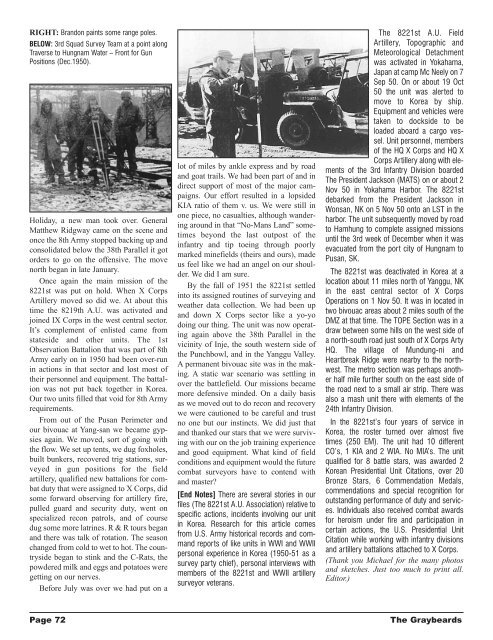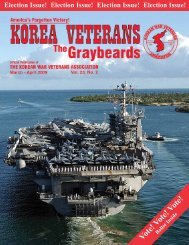The Graybeards - KWVA - Korean War Veterans Association
The Graybeards - KWVA - Korean War Veterans Association
The Graybeards - KWVA - Korean War Veterans Association
Create successful ePaper yourself
Turn your PDF publications into a flip-book with our unique Google optimized e-Paper software.
RIGHT: Brandon paints some range poles.<br />
BELOW: 3rd Squad Survey Team at a point along<br />
Traverse to Hungnam Water – Front for Gun<br />
Positions (Dec.1950).<br />
Holiday, a new man took over. General<br />
Matthew Ridgway came on the scene and<br />
once the 8th Army stopped backing up and<br />
consolidated below the 38th Parallel it got<br />
orders to go on the offensive. <strong>The</strong> move<br />
north began in late January.<br />
Once again the main mission of the<br />
8221st was put on hold. When X Corps<br />
Artillery moved so did we. At about this<br />
time the 8219th A.U. was activated and<br />
joined IX Corps in the west central sector.<br />
It’s complement of enlisted came from<br />
stateside and other units. <strong>The</strong> 1st<br />
Observation Battalion that was part of 8th<br />
Army early on in 1950 had been over-run<br />
in actions in that sector and lost most of<br />
their personnel and equipment. <strong>The</strong> battalion<br />
was not put back together in Korea.<br />
Our two units filled that void for 8th Army<br />
requirements.<br />
From out of the Pusan Perimeter and<br />
our bivouac at Yang-san we became gypsies<br />
again. We moved, sort of going with<br />
the flow. We set up tents, we dug foxholes,<br />
built bunkers, recovered trig stations, surveyed<br />
in gun positions for the field<br />
artillery, qualified new battalions for combat<br />
duty that were assigned to X Corps, did<br />
some forward observing for artillery fire,<br />
pulled guard and security duty, went on<br />
specialized recon patrols, and of course<br />
dug some more latrines. R & R tours began<br />
and there was talk of rotation. <strong>The</strong> season<br />
changed from cold to wet to hot. <strong>The</strong> countryside<br />
began to stink and the C-Rats, the<br />
powdered milk and eggs and potatoes were<br />
getting on our nerves.<br />
Before July was over we had put on a<br />
lot of miles by ankle express and by road<br />
and goat trails. We had been part of and in<br />
direct support of most of the major campaigns.<br />
Our effort resulted in a lopsided<br />
KIA ratio of them v. us. We were still in<br />
one piece, no casualties, although wandering<br />
around in that “No-Mans Land” sometimes<br />
beyond the last outpost of the<br />
infantry and tip toeing through poorly<br />
marked minefields (theirs and ours), made<br />
us feel like we had an angel on our shoulder.<br />
We did I am sure.<br />
By the fall of 1951 the 8221st settled<br />
into its assigned routines of surveying and<br />
weather data collection. We had been up<br />
and down X Corps sector like a yo-yo<br />
doing our thing. <strong>The</strong> unit was now operating<br />
again above the 38th Parallel in the<br />
vicinity of Inje, the south western side of<br />
the Punchbowl, and in the Yanggu Valley.<br />
A permanent bivouac site was in the making.<br />
A static war scenario was settling in<br />
over the battlefield. Our missions became<br />
more defensive minded. On a daily basis<br />
as we moved out to do recon and recovery<br />
we were cautioned to be careful and trust<br />
no one but our instincts. We did just that<br />
and thanked our stars that we were surviving<br />
with our on the job training experience<br />
and good equipment. What kind of field<br />
conditions and equipment would the future<br />
combat surveyors have to contend with<br />
and master?<br />
[End Notes] <strong>The</strong>re are several stories in our<br />
files (<strong>The</strong> 8221st A.U. <strong>Association</strong>) relative to<br />
specific actions, incidents involving our unit<br />
in Korea. Research for this article comes<br />
from U.S. Army historical records and command<br />
reports of like units in WWI and WWII<br />
personal experience in Korea (1950-51 as a<br />
survey party chief), personal interviews with<br />
members of the 8221st and WWII artillery<br />
surveyor veterans.<br />
<strong>The</strong> 8221st A.U. Field<br />
Artillery, Topographic and<br />
Meteorological Detachment<br />
was activated in Yokahama,<br />
Japan at camp Mc Neely on 7<br />
Sep 50. On or about 19 Oct<br />
50 the unit was alerted to<br />
move to Korea by ship.<br />
Equipment and vehicles were<br />
taken to dockside to be<br />
loaded aboard a cargo vessel.<br />
Unit personnel, members<br />
of the HQ X Corps and HQ X<br />
Corps Artillery along with elements<br />
of the 3rd Infantry Division boarded<br />
<strong>The</strong> President Jackson (MATS) on or about 2<br />
Nov 50 in Yokahama Harbor. <strong>The</strong> 8221st<br />
debarked from the President Jackson in<br />
Wonsan, NK on 5 Nov 50 onto an LST in the<br />
harbor. <strong>The</strong> unit subsequently moved by road<br />
to Hamhung to complete assigned missions<br />
until the 3rd week of December when it was<br />
evacuated from the port city of Hungnam to<br />
Pusan, SK.<br />
<strong>The</strong> 8221st was deactivated in Korea at a<br />
location about 11 miles north of Yanggu, NK<br />
in the east central sector of X Corps<br />
Operations on 1 Nov 50. It was in located in<br />
two bivouac areas about 2 miles south of the<br />
DMZ at that time. <strong>The</strong> TOPE Section was in a<br />
draw between some hills on the west side of<br />
a north-south road just south of X Corps Arty<br />
HQ. <strong>The</strong> village of Mundung-ni and<br />
Heartbreak Ridge were nearby to the northwest.<br />
<strong>The</strong> metro section was perhaps another<br />
half mile further south on the east side of<br />
the road next to a small air strip. <strong>The</strong>re was<br />
also a mash unit there with elements of the<br />
24th Infantry Division.<br />
In the 8221st’s four years of service in<br />
Korea, the roster turned over almost five<br />
times (250 EM). <strong>The</strong> unit had 10 different<br />
CO’s, 1 KIA and 2 WIA. No MIA’s. <strong>The</strong> unit<br />
qualified for 8 battle stars, was awarded 2<br />
<strong>Korean</strong> Presidential Unit Citations, over 20<br />
Bronze Stars, 6 Commendation Medals,<br />
commendations and special recognition for<br />
outstanding performance of duty and services.<br />
Individuals also received combat awards<br />
for heroism under fire and participation in<br />
certain actions, the U.S. Presidential Unit<br />
Citation while working with infantry divisions<br />
and artillery battalions attached to X Corps.<br />
(Thank you Michael for the many photos<br />
and sketches. Just too much to print all.<br />
Editor.)<br />
Page 72<br />
<strong>The</strong> <strong>Graybeards</strong>
















